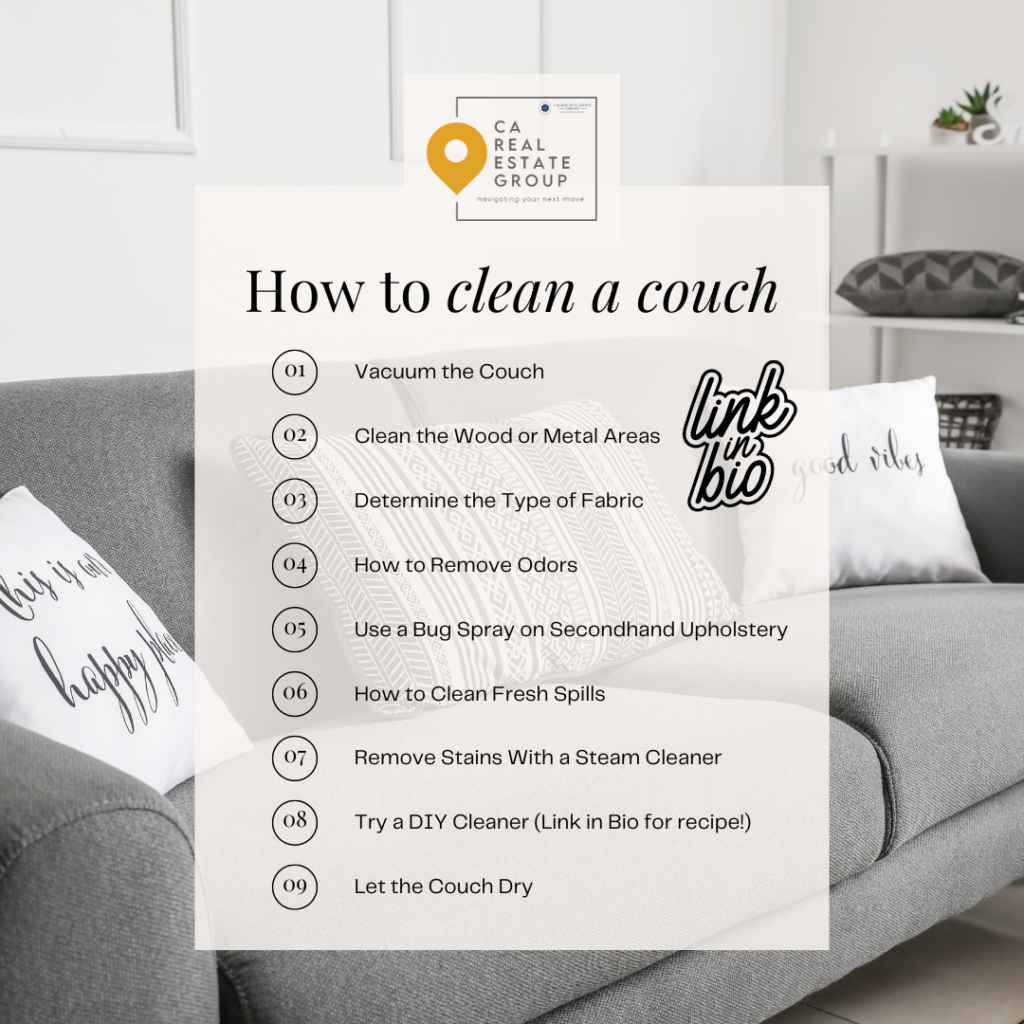Got tough pet stains on your sofa or maybe you found a cute secondhand couch? Here’s how to get that upholstery looking and smelling good as new.
1. Vacuum the Couch
2. Clean the Wood or Metal Areas
3. Determine the Type of Fabric
- WS: Use a mild detergent with a steam vacuum or a dry-cleaning detergent.
- S: Use a dry cleaner detergent only.
- X: Use a vacuum only. No water.
- W: You can use water to clean it.
4. How to Remove Odors
5. Use a Bug Spray on Secondhand Upholstery
Even if you know that pre-loved sofa came from a clean home, it’s best to be cautious and treat it with some pest control. Many commercial sprays are non-toxic and safe for kids and pets. Another option is to sprinkle the upholstery with diatomaceous earth and let it sit for several hours then vacuum it up.
6. How to Clean Fresh Spills
Start by blotting liquid spills. Use an absorbent cloth to first blot at spills and moisture to quickly absorb it. This will help reduce the chance that the stain will get “rubbed in,” and it’ll help to collect liquid that’s soaking into foam layers beneath the upholstery. The more liquid you can absorb by blotting, the less internal damage that happens to your furnishings.
7. Remove Stains With a Steam Cleaner
8. Try a DIY Cleaner
- For fabric upholstery: Mix 1/4 cup vinegar, 3/4 warm water and 1 tablespoon of dish soap or Castile soap. Put in a spray bottle. Mist the soiled area. Scrub with a soft cloth until the stain lifts. Use a second cloth moistened with clean water to remove the soap. Dry with a towel.
- For leather upholstery. Mix 1/2 cup olive oil with 1/4 cup vinegar and put into a spray bottle. Spray the cleaner on the surface of the couch and buff with a soft cloth.
- For synthetic upholstery: Mix 1/2 cup of vinegar, 1 cup of warm water and 1/2 tablespoon of liquid dish soap or Castile soap in a spray bottle. Mist the soiled area and scrub with a soft cloth until the stain is gone.
9. Let the Couch Dry
More Couch Cleaning Tips
Lint Roller
If your couch is made from a fabric that easily attracts lint, hair or dust, you should keep a lint roller on hand that you can exclusively use for your couch. This works best for a couch that only requires a light amount of de-linting, but it can work for larger jobs, too. In a pinch, you can use large pieces of packing tape to de-puppify the couch.
If your couch is made from a fabric that easily attracts lint, hair or dust, you should keep a lint roller on hand that you can exclusively use for your couch. This works best for a couch that only requires a light amount of de-linting, but it can work for larger jobs, too. In a pinch, you can use large pieces of packing tape to de-puppify the couch.
Leather Soap and Conditioner
If you have a leather couch, leather soap and conditioner are something you can use to keep it looking clean and fresh. You also can use a slightly damp, clean rag to wipe off my leather furniture about once a week.
Steam
If your couch is made of a fabric that can be cleaned with a water-based cleaner, try using steam to loosen up dirt and stains. Try this: Grab your iron, put it on the “steam” setting, and wave it back and forth across any trouble spots on your couch.
How to clean a microfiber couch
If your couch is made of a fabric that can be cleaned with a water-based cleaner, try using steam to loosen up dirt and stains. Try this: Grab your iron, put it on the “steam” setting, and wave it back and forth across any trouble spots on your couch.
Price and stock could change after publish date, and HGTV may make money off these affiliate links. Learn more.

